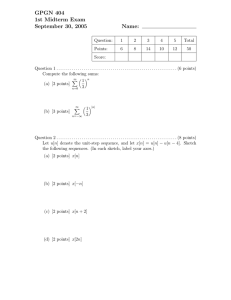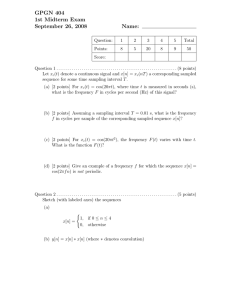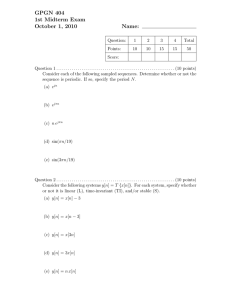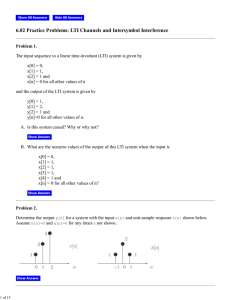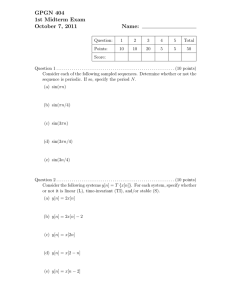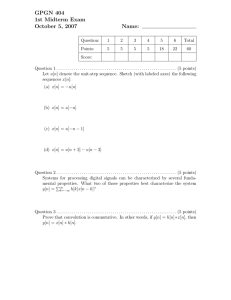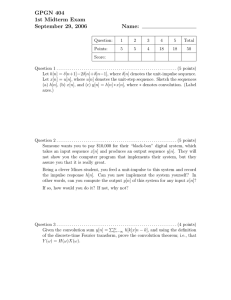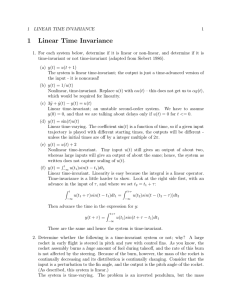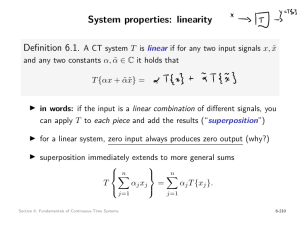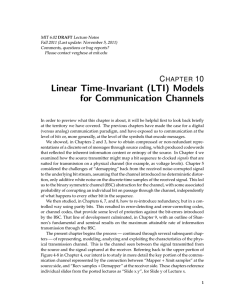3 Signals and Systems: Part II Recommended Problems
advertisement
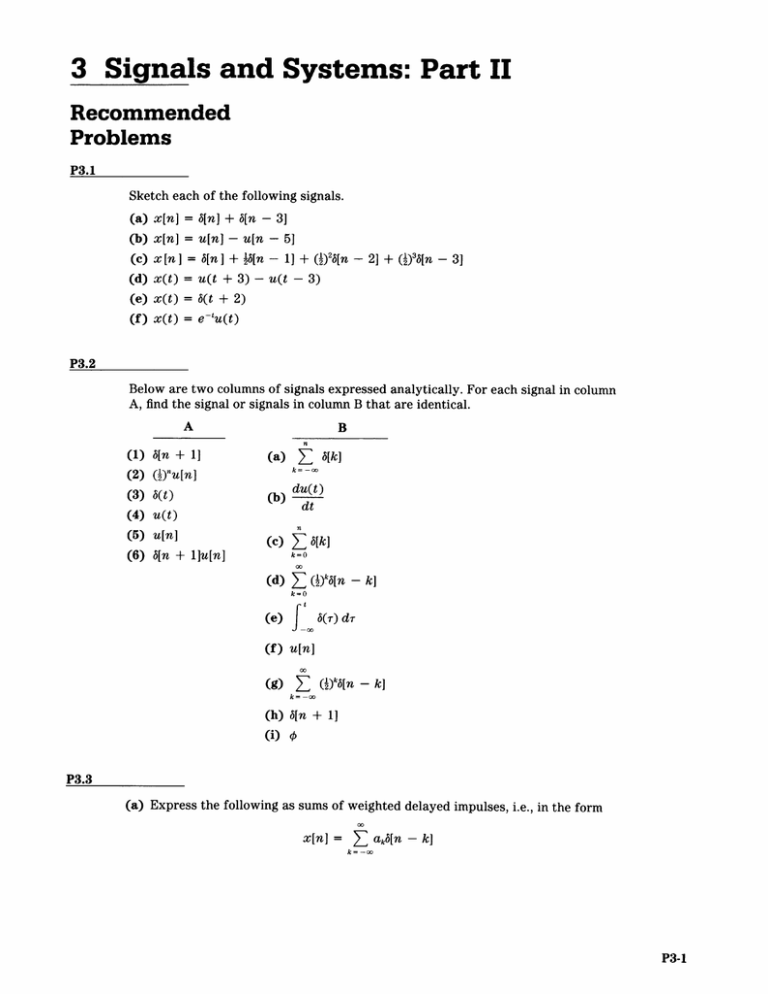
3 Signals and Systems: Part II Recommended Problems P3.1 Sketch each of the following signals. (a) x[n] = b[n] + 3[n - 3] (b) x[n] = u[n] - u[n - 5] + (c) x[n] = 6[n] + 1n (i)2 [n - (d) x(t) = u(t + 3) - u(t - 3) (e) x(t) = (f) x(t) = 6(t + 2) e-'u(t) 2] + (i)ag[n - 3] P3.2 Below are two columns of signals expressed analytically. For each signal in column A, find the signal or signals in column B that are identical. A (1) 6[n + 1] (2) (I)"U [n] (3) 6(t) B (a) 6 t[k] k=-0 (b) du(t) (4) u(t) (5) u[n] (C) (6) b[n + 1]u[n] 6[k] k=O (d) L k] - (I)k[n k=O (e) J t6(r) dr (f) u[n] (g) E (I)kb[n - k] k= -oo (h) b[n + 1] (i) $ P3.3 (a) Express the following as sums of weighted delayed impulses, i.e., in the form x[n] = ( ako[n - k] k= -o P3-1 Signals and Systems P3-2 x [n] 2 -3 -2 -1 1 0 4 2 4? 3 5 6 7 8 -2 Figure P3.3-1 (b) Express the following sequence as a sum of step functions, i.e., in the form ( s[n] = aku[n - k] k= -00 s[n] 3 -3 -2 2 10 -1 -6-5-4 -1 0 1- 3 1 4 0 5 n 6 ­ Figure P3.3-2 P3.4 For x(t) indicated in Figure P3.4, sketch the following: x(1 - t)[u(t + 1) - u(t - 2)] (b) x(1 - t)[u(t + 1) - u(2 - 3t)] (a) x(t) 12 0 Figure P3.4 Signals and Systems: Part II / Problems P3-3 P3.5 Consider the three systems H, G, and F defined in Figure P3.5-1. x [n] H x[n] G x [n F y[n]=x2 [nJ . y[n]=x[n]-x[n-1] y[n]=2x[n]+x[n-1] Figure P3.5-1 The systems in Figures P3.5-2 to P3.5-7 are formed by parallel and cascade combi­ nation of H, G, and F. By expressing the output y[n] in terms of the input x[n], determine which of the systems are equivalent. (b) (a) H x G + x y + y H Figure P3.5-3 Figure P3.5-2 (d) (c) x-- H G X- Y H + G -- WY Figure P3.5-5 Figure P3.5-4 (e) x -- (f) G Figure P3.5-6 F Y x -- F G Y Figure P3.5-7 P3.6 Table P3.6 contains the input-output relations for several continuous-time and dis­ crete-time systems, where x(t) or x[n] is the input. Indicate whether the property along the top row applies to each system by answering yes or no in the appropriate boxes. Do not mark the shaded boxes. Signals and Systems P3-4 Properties y(t), y[n] Memoryless Linear Time-Invariant Causal Invertible Stable Table P3.6 P3.7 Consider the following systems H: y(t) = G: y(t) = x(2t), x(r) dr (an integrator), where the input is x(t) and the output is y(t). (a) What is H-', the inverse of H? What is G- ? (b) Consider the system in Figure P3.7. Find the inverse F-1 and draw it in block diagram form in terms of H-1 and G-1. x(t) --- H x(t) w(t) G F --- Figure P3.7 o w(t) Signals and Systems: Part II / Problems P3-5 Optional Problems P3.8 In this problem we illustrate one of the most important consequences of the prop­ erties of linearity and time invariance. Specifically, once we know the response of a linear system or of a linear, time-invariant (LTI) system to a single input or the responses to several inputs, we can directly compute the responses to many other input signals. (a) Consider an LTI system whose response to the signal x 1(t) in Figure P3.8-1(a) is the signal y 1(t) illustrated in Figure P8-1(b). Determine and sketch carefully the response of the system to the input x 2(t) depicted in Figure P3.8-1(c). Y1 (t) x1 (t) 2 1 0 1 2 1 1 0 2 t (b) (a) x3 (t) x 2 (t) 2 1 1 1 i 7 2 t4-101 -1 (d) (c) x(t 0 1 2 (e) Figure P3.8-1 (b) Determine and sketch the response of the system considered in part (a) to the input x 3 (t) shown in Figure P3.8-1(d). Signals and Systems P3-6 (c) Suppose that a second LTI system has the following output y(t) when the input is the unit step x(t) = u(t): y(t) = e-'u(t) + u(-1 - t) Determine and sketch the response of this system to the input x(t) shown in Figure P3.8-1(e). (d) Suppose that a particular discrete-time linear (but possibly not time-invariant) system has the responses yi[n], y2[n], and yAn] to the input signals xi[n], x2[n], and x[n], respectively, as illustrated in Figure P3.8-2(a). If the input to this system is x[n] as illustrated in Figure P3.8-2(b), what is the output y[n]? x, [n] y, [n] 1 0 X2 n 0 1 2 3 0 0 1 n 1 3 y 3 [n] 0p 0 2 Y 2 [n] [n] x 3 [n] a . - -1 0pop 0 o n . -..- 1 4 4 2 -1 1 ­ . n 3 (a) x[n] 2 n -1 0 -2 (b) Figure P3.8-2 (e) If an LTI system has the response y1[n] to the input xi[n] as in Figure P3.8-2(a), what would its responses be to x 2[n] and x 3[n]? (f) A particular linear system has the property that the response to t' is cos kt. What is the response of this system to the inputs x 1 (t) = ,r + 6t 2 - 47t 5 + \/et6 1+ x 2(t) = 1 +t t0 2 Signals and Systems: Part II / Problems P3-7 P3.9 (a) Consider a system with input x(t) and with output y(t) given by +0o y(t) (i) (ii) = ( x(t)b(t - nT) Is this system linear? Is this system time-invariant? For each part, if your answer is yes, show why this is so. If your answer is no, produce a counterexample. (b) Suppose that the input to this system is x(t) = cos 27rt. Sketch and label care­ fully the output y(t) for each of the following values of T: T = 1, 1, 1, 1, -. All of your sketches should have the same horizontal and vertical scales. (c) Repeat part (b) for x(t) = e' cos 27rt. P3.10 (a) Is the following statement true or false? The series interconnection of two linear, time-invariant systems is itself a lin­ ear, time-invariant system. Justify your answer. (b) Is the following statement true or false? The series connection of two nonlinear systems is itself nonlinear. Justify your answer. (c) Consider three systems with the following input-output relations: x[n/2], y[n] = 1o, System 1: n even n odd y[n] = x[n] + 1x[n - 1] + y[n] = x[2n] System 2: System 3: ix[n - 2] Suppose that these systems are connected in series as depicted in Figure P3.10. Find the input-output relation for the overall interconnected system. Is this sys­ tem linear? Is it time-invariant? x[n] System 1 - System 2 System 3 y[n] Figure P3.10 (d) Consider a second series interconnection of the form of Figure P3.10 where the three systems are specified by the following equations, with a, b, and c real numbers: System 1: System 2: System 3: y[n] = x[-n] y[n] = ax[n - 1] + bx[n] + cx[n + 1] y[n] = x[-n] Signals and Systems P3-8 Find the input-output relation for the overall interconnected system. Under what conditions on the numbers a, b, and c does the overall system have each of the following properties? The The tem (iii) The (i) (ii) overall system is linear and time-invariant. input-output relation of the overall system is identical to that of sys­ 2. overall system is causal. P3.11 Determine whether each of the following systems is linear and/or time-invariant. In each case, x[n] denotes the input and y[n] denotes the output. Assume that x[] > 0. (a) y[n] = x[n] + x[n - 1] (b) y[n] = x[n] + x[n - 1] + x[O] P3.12 (a) Show that causality for a continuous-time linear system implies the following statement: For any time to and any input x(t) such that x(t) = 0 for t < to, the correspond­ ing output y(t) must also be zero for t < to. The analogous statement can be made for discrete-time linear systems. (b) Find a nonlinear system that satisfies this condition but is not causal. (c) Find a nonlinear system that is causal but does not satisfy this condition. (d) Show that invertibility for a discrete-time linear system is equivalent to the fol­ lowing statement: The only input that produces the output y[n] = 0 for all n is x[n] = 0 for all n. The analogous statement is also true for continuous-time linear systems. (e) Find a nonlinear system that satisfies the condition of part (d) but is not invertible. MIT OpenCourseWare http://ocw.mit.edu Resource: Signals and Systems Professor Alan V. Oppenheim The following may not correspond to a particular course on MIT OpenCourseWare, but has been provided by the author as an individual learning resource. For information about citing these materials or our Terms of Use, visit: http://ocw.mit.edu/terms.
